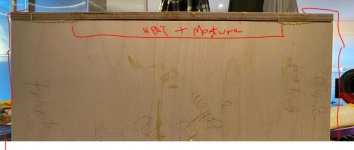sebr023
Member
Hi all!
Don’t know if I’m in the right section of the forum.
But I’m building some cabinet for some home theater speaker. I’ve already glued up the left and right speaker. Yesterday I glued the Center speaker.
Ive had my share of mistake on building the left and right speaker as I’m a beginner woodworker. But nothing I wasn’t able to solve or I couldnt live with.
I made a “bigger” mistake on the glue up for this cabinet. There’s a 1/16 gap on one of the edge of the cabinet.
The 100$ question: how could I save this?
A friends of mine told me that wood glue doesn’t stick to cured wood glue. 1/16 is a bit thight to go and sand/scrap cured wood glue.
If I clamp this, I am able to bring the cap tighter, but obviously I would need some glue to hold it.
The cabinet is birch plywood and I wanted them to stay that way, meaning I don’t plan on veneering them.
This is the orientation of the speaker, layed on its side.

The 1/16 gap is the middle :

2ft level to show the “bulge” (sorry lack of a better word) it causes.

If I don’t clamp and reduce the gap, the bulge will stay, and I will need to find a way to sand away the bulge, probably going through the birch veneer on the top of the plywood.
But I could pmace this face down, so it wouldn’t be a big deal I guess?!
Anyway, thank for your time and answer. Looking forward to read more advanced woodworker on this problem!
Thanks!
Sent from my iPhone using Tapatalk
Don’t know if I’m in the right section of the forum.
But I’m building some cabinet for some home theater speaker. I’ve already glued up the left and right speaker. Yesterday I glued the Center speaker.
Ive had my share of mistake on building the left and right speaker as I’m a beginner woodworker. But nothing I wasn’t able to solve or I couldnt live with.
I made a “bigger” mistake on the glue up for this cabinet. There’s a 1/16 gap on one of the edge of the cabinet.
The 100$ question: how could I save this?
A friends of mine told me that wood glue doesn’t stick to cured wood glue. 1/16 is a bit thight to go and sand/scrap cured wood glue.
If I clamp this, I am able to bring the cap tighter, but obviously I would need some glue to hold it.
The cabinet is birch plywood and I wanted them to stay that way, meaning I don’t plan on veneering them.
This is the orientation of the speaker, layed on its side.

The 1/16 gap is the middle :

2ft level to show the “bulge” (sorry lack of a better word) it causes.

If I don’t clamp and reduce the gap, the bulge will stay, and I will need to find a way to sand away the bulge, probably going through the birch veneer on the top of the plywood.
But I could pmace this face down, so it wouldn’t be a big deal I guess?!
Anyway, thank for your time and answer. Looking forward to read more advanced woodworker on this problem!
Thanks!
Sent from my iPhone using Tapatalk




